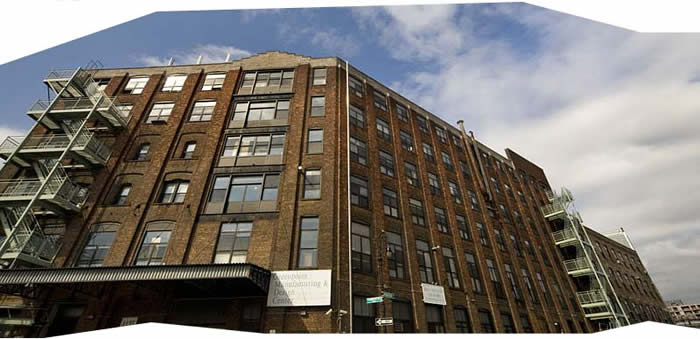 Construction on the Chelsea Fiber Mills complex at 1155-1205 Manhattan Avenue began about 1868. The site marks the confluence of Newtown Creek, an industrial waterway that forms a natural boundary between Brooklyn and Queens, and the East River. In the beginning, the Chelsea Fiber Mills consisted of a few brick buildings along the waterfront. Structures added later facilitated greater production and storage. By the turn of the century, eight buildings housed 366,000 square feet of industrial space and basement area. The jute mill manufactured finished marine rope from sisal, manila, jute, and hemp.
Construction on the Chelsea Fiber Mills complex at 1155-1205 Manhattan Avenue began about 1868. The site marks the confluence of Newtown Creek, an industrial waterway that forms a natural boundary between Brooklyn and Queens, and the East River. In the beginning, the Chelsea Fiber Mills consisted of a few brick buildings along the waterfront. Structures added later facilitated greater production and storage. By the turn of the century, eight buildings housed 366,000 square feet of industrial space and basement area. The jute mill manufactured finished marine rope from sisal, manila, jute, and hemp.
Early builder’s drawings show large loading bays on the waterfront where raw materials were off loaded from ships arriving from around the globe. These drawings also show a series of tracks that ran across the rooftops of lower buildings, which workers used to move coal from waterfront loading areas to a coal chute on top of the facility. The coal was shoveled into furnaces that created heat and process steam. The original gargantuan boilers–more than two stories tall and big enough to fill a baseball diamond–remain in place today. The welded boilerplates on these boilers read 1880.
Chelsea was not the only rope making concern in Greenpoint. Several blocks south on the East River stood an even larger industrial complex, the American Manufacturing Company (AMC), built around the same time. AMC, like Chelsea Fiber, imported raw materials from many continents to produce marine rope. North Brooklyn was somewhat of a rope mecca in the early part of the century. According to the Brooklyn Eagle, North Brooklyn’s rope mills employed 4,000 people, making rope production one of Brooklyn’s largest industries.
The Chelsea Fiber Mills employed scores of Greenpoint residents. Many lived in nearby railroad apartments, apartment buildings, and tenements. Others came from Queens, walking across what was then called the Vernon Avenue Bridge. The bridge connected Vernon Avenue in Long Island City, Queens, to Manhattan Avenue, Greenpoint’s primary commercial corridor. At the time, a trolley ran up and down Manhattan Avenue. The turnaround barn for the trolley was directly across the street from the Chelsea Fiber Mills. Lifelong Greenpointers remember parents and other relatives’ working for Chelsea Fiber.
The bustling Chelsea Mills supplied the U.S. military throughout World War I and World War II, but like many waterfront mills throughout the northeast, Chelsea Fiber declined in activity during the second half of the 20th century. The company left, and the facility became home to textile producers and fabric dyeing mills. These industrial uses prevailed until the early 1970s.
The City of New York took over the building in a tax foreclosure in 1974. The City held title to the property but lacked the funds to maintain or upgrade the structure. Rust, corrosion, and decay prevailed. The buildings’ systems began to fail, including elevators, sprinklers, roofing, electricity, and water distribution systems. Despite these challenging conditions, a group of commercial tenants set up production shops and artist’s studios. The City gave these occupants month-to-month leases, a reflection of its ambivalence about the future of the complex.
By the middle of the 1980s, the 1155-1205 Manhattan Avenue facility, like many mill buildings throughout the region, had an uncertain future. The City, realizing the urgency of repairs needed to the property, invited private developers to the site to test its marketability as a residential conversion project, but no parties were interested. The City considered either sealing or demolishing the complex because the cost and effort of upgrading the buildings exceeded the City’s means. Within a few years, local businesses, community organizations, building tenants, and elected officials came together to shape a redevelopment plan that would convert the property into an arts and industry center.
In the early 1990s, these business and community stakeholders helped support the formation of a development deal with the City of New York. GMDC, acting as a nonprofit local development corporation, acquired the property and leveraged the public and private capital required to reactivate the complex. Although slow at first, the redevelopment gathered momentum over time, and eventually the site became a more stable home for small manufacturers and artisans.
A secondary, but important, goal was to save the buildings’ historic architecture. This is how GMDC’s dual mission of historic preservation and urban development was born.
Today, the Manhattan Avenue complex has 76 small business and artisan tenants, and 360 employees from adjacent communities work here.
- 366,000 square feet
- 80 units with a large variety of tenants
- 106 kW solar power array
- Located in the East Williamsburg Empire Zone & North Brooklyn Industrial Business Zone
